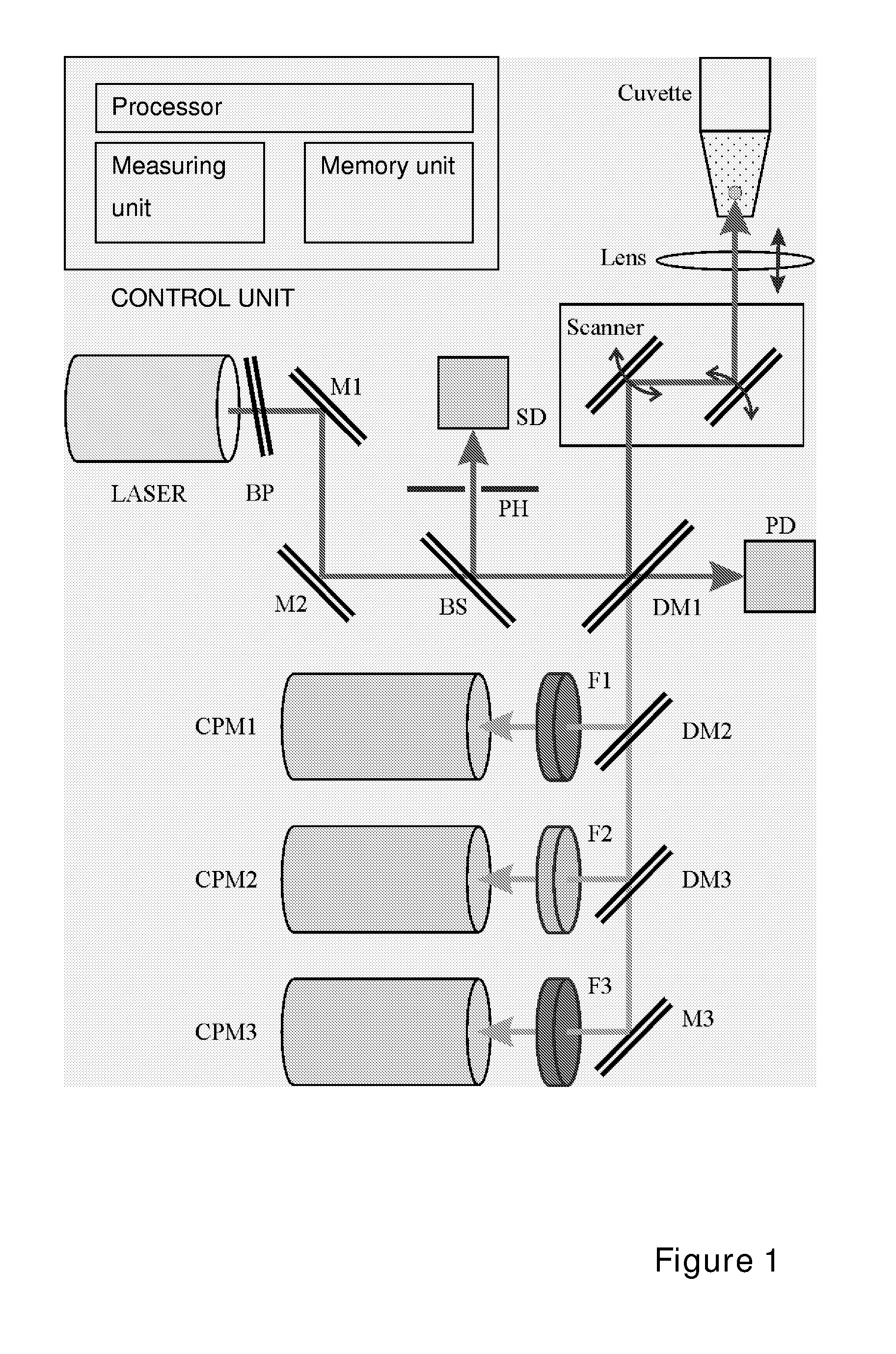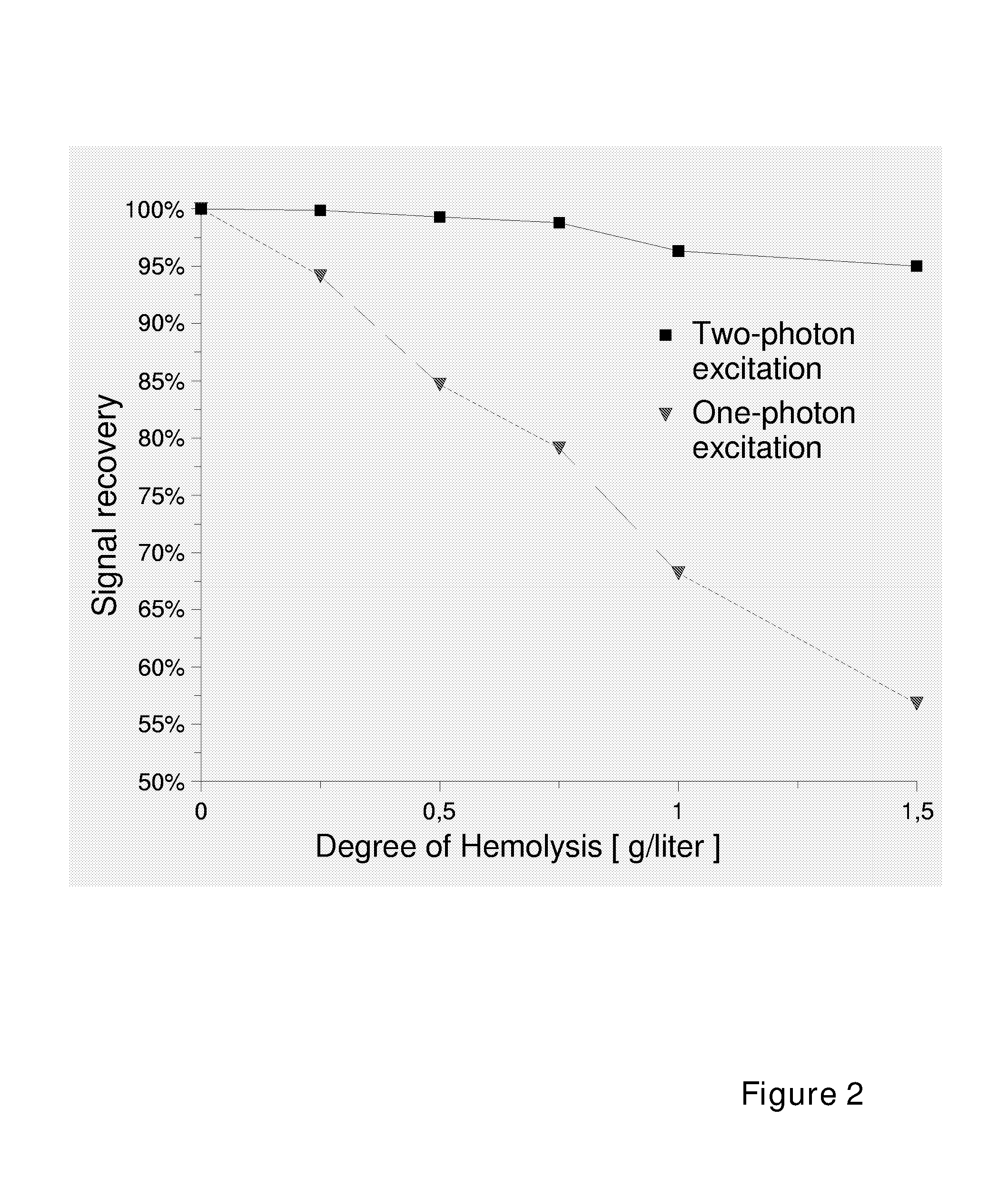Use of Two-Photon Excited Fluorescence in Assays of Clinical Chemistry Analytes
a technology of clinical chemistry and fluorescence, applied in the field of clinical chemistry, can solve the problems of high cost of cuvettes for clinical chemistry assays, inconvenient use, and inconvenient use, and achieve the effects of improving the accuracy of clinical chemistry assays
- Summary
- Abstract
- Description
- Claims
- Application Information
AI Technical Summary
Benefits of technology
Problems solved by technology
Method used
Image
Examples
example 1
[0146] Interference of Hemolysis on Signal Intensity of One-Photon Excited Fluorescence and Two-Photon Excited Fluorescence
[0147] Bovine serum albumin (BSA) was labeled with a fluorescent labeling reagent, ArcDia BF560 (Arctic Diagnostic Oy, Turku, Finland) to give label-BSA conjugate with substitution degree of 2.7. The conjugate was diluted with hemoglobin solution (variable concentration of hemoglobin, TRIS 50 mM, NaCl 150 mM, NaN3 10 mM, Tween 20 0.01%, BSA 0.5%, pH 8.0) to concentration of 100 nM. This solution was dispensed in the wells of a microtitration plate of either 384-well format (Greiner BIO-One GmbH, Code: 788096, μClear SV-plate, 2nd Gen, with black walls and plastic foil bottom) or 96-well format (Greiner BIO-One GmbH, code 655096) in aliquots of 10 and 100 μl, respectively. The 96-well plate was measured with a conventional one-photon excitation fluorometer (Ascent, Thermo Electron Oy, Vantaa, Finland) using excitation filter of 530 nm and emission filter 590 nm....
example 2
[0148] Effect of Cuvette Material on Inter-Cuvette Precision
[0149] Mouse monoclonal antibody was labeled with fluorescent label ArcDia BF 560-SE (Arctic Diagnostics Oy, Turku, Finland) according to a standard protocol [M. E. Waris et al. Anal. Biochem. 309 (2002), 67-74] to give a conjugate with substitution degree of 3.2 labels per IgG. The conjugate was diluted with buffer (TRIS 50, NaCl 150 mM, NaN3 10 mM, BSA 0.5%, Tween 20 0.01%, pH, 8.0) to concentration of 50 nM and dispensed into wells of two different microplates of 384-well format. One of the microplates was a low-cost standard microplate with plastic foil bottom window (Greiner BIO-One GmbH, Code: 788096, μClear SV-plate, 2nd Gen, with black walls and plastic foil bottom) while the other was a special plate with bottom window made of the highest quality optical glass (Greiner, SensoPlate™ 96 Well). The samples were measured with the two-photon excitation microfluorometer (ArcDia TPX Plate Reader, described in Example 1) ...
example 3
[0150] Assay of Total Bilirubin
[0151] The assay for total bilirubin was performed according to a modification of the assay protocol for total bilirubin of Sigma Diagnostics® (procedure no 605), which is based on the reaction between bilirubin and diazonium salts. The assay procedure no. 605 was followed with an exception that the addition of the alkaline tartrate reagent was omitted. Bilirubin was dissolved in a mixture containing 1 part dimethyl sulfoxide and 2 parts sodium carbonate (100 mM, aq.), and diluted further with buffer (Bovine serum albumin 40 g / l, TRIS 100 mM, pH 7.4) to give bilirubin standards of 2, 5, 10, 15 and 20 mg / dl. 2 μl of a bilirubin standard sample was dispensed in a assay cuvette (384-well plate, Greiner BIO-ONE GmbH, Code: 788096), followed by addition of caffeine solution (10 μl, caffeine 25 g / l, sodium benzoate 38 g / l, in NaAc solution, code 605-2, Sigma) and diazo reagent solution (5 μl, sulfanilic acid 1.25 mM, NaNO2 1 mM, HCl 0.05 M). The mixture was...
PUM
 Login to View More
Login to View More Abstract
Description
Claims
Application Information
 Login to View More
Login to View More - R&D
- Intellectual Property
- Life Sciences
- Materials
- Tech Scout
- Unparalleled Data Quality
- Higher Quality Content
- 60% Fewer Hallucinations
Browse by: Latest US Patents, China's latest patents, Technical Efficacy Thesaurus, Application Domain, Technology Topic, Popular Technical Reports.
© 2025 PatSnap. All rights reserved.Legal|Privacy policy|Modern Slavery Act Transparency Statement|Sitemap|About US| Contact US: help@patsnap.com



